Analysis of Business Operations, Cycle Time, and Flow Chart
VerifiedAdded on 2020/05/16
|13
|3087
|132
Report
AI Summary
This report provides a detailed analysis of business operations, focusing on process architecture, cycle time, and flow chart development within a 3PL (Third-Party Logistics) context. It examines the components of business operations, including inputs/outputs, information, flow units, business network activities, buffers, and resources. The report identifies tangible and intangible components, such as customers, products, cash, and information, and explores their impact on business processes. A significant portion of the report addresses the issue of increased cycle time, offering solutions such as implementing updated technology, increasing service points, and improving employee relations. The report also includes a flow chart with swim lanes illustrating the order processing and purchasing processes. The report aims to provide insights into optimizing business processes to improve efficiency and customer satisfaction, addressing challenges related to low product outflow and identifying areas for improvement within the supply chain. The report also discusses how to reduce cycle time and improve business operations.
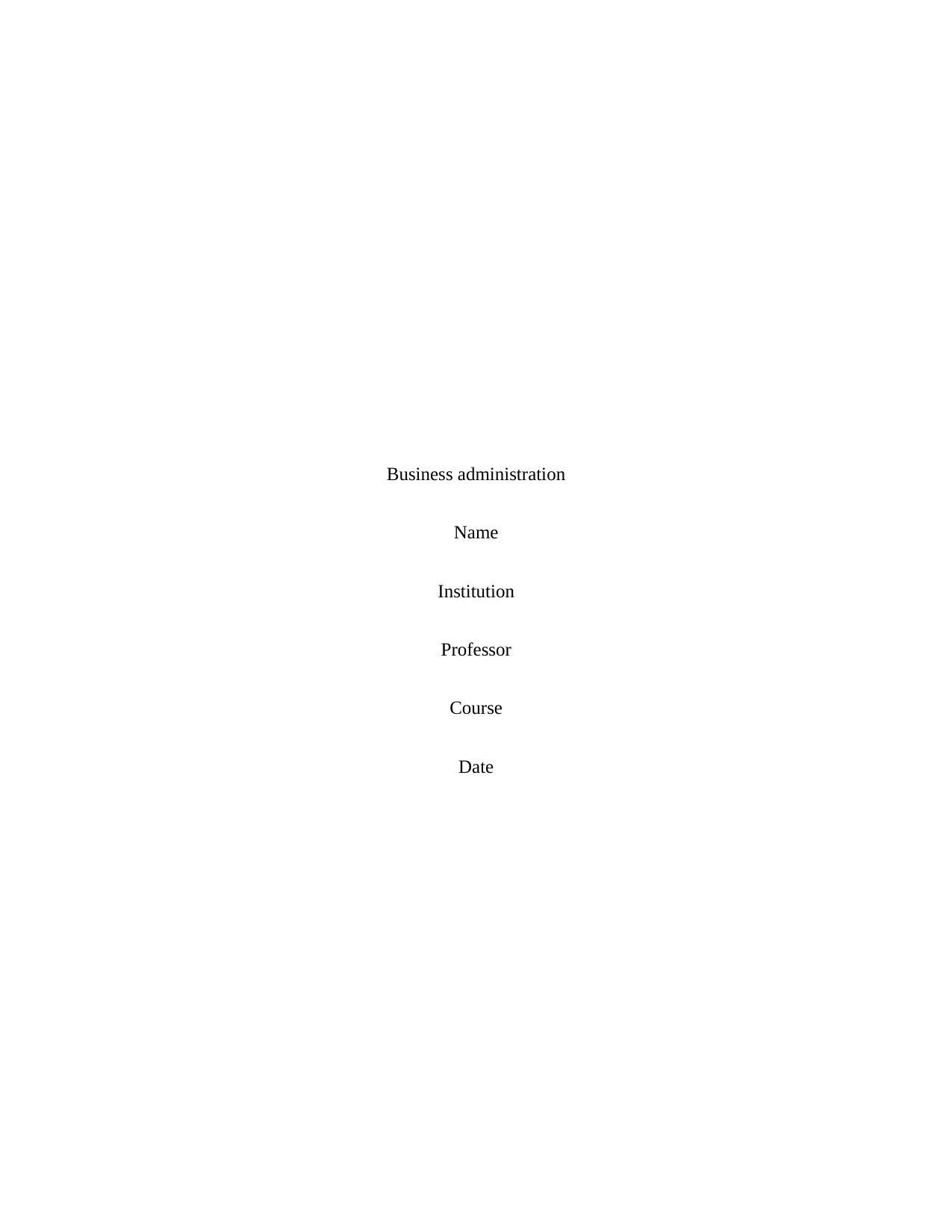
Business administration
Name
Institution
Professor
Course
Date
Name
Institution
Professor
Course
Date
Paraphrase This Document
Need a fresh take? Get an instant paraphrase of this document with our AI Paraphraser
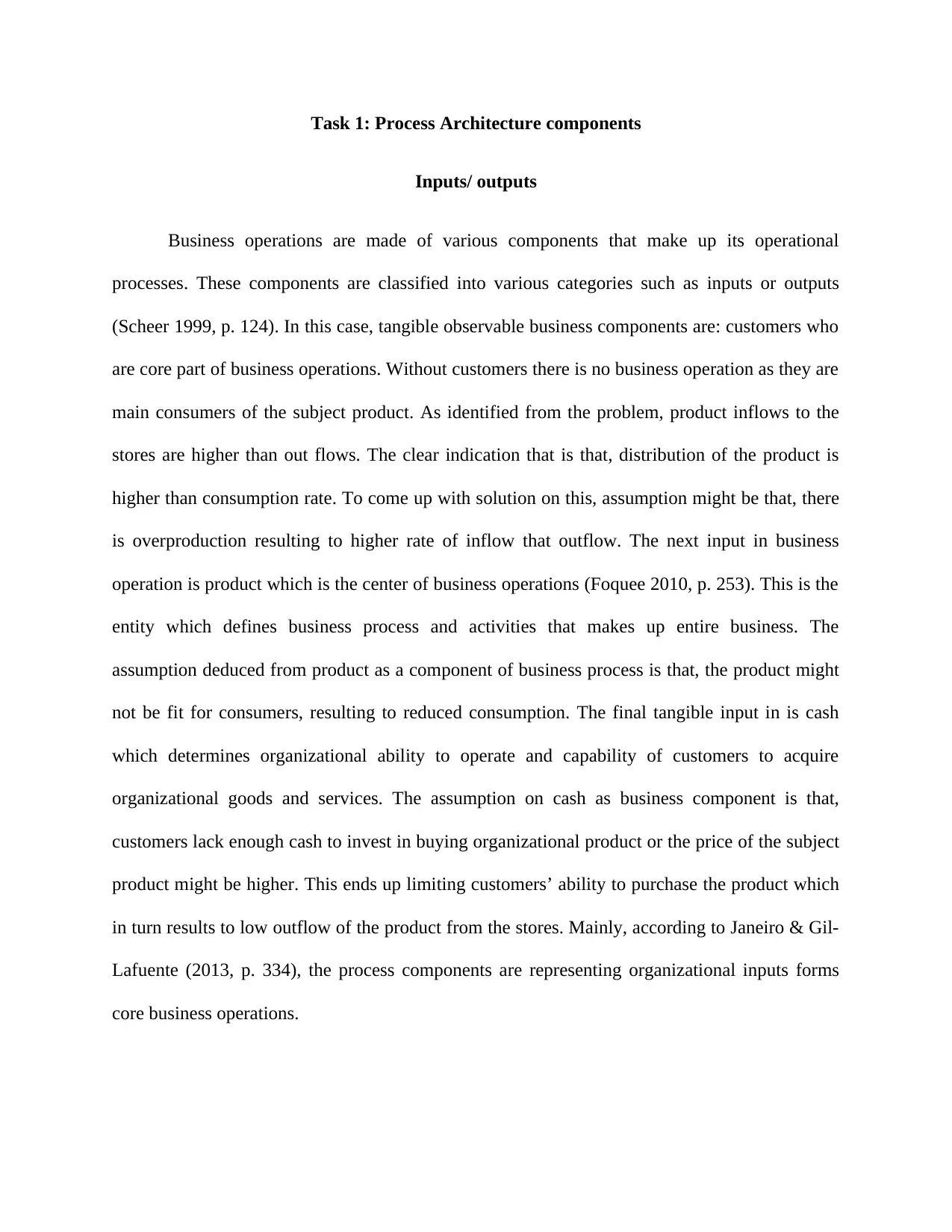
Task 1: Process Architecture components
Inputs/ outputs
Business operations are made of various components that make up its operational
processes. These components are classified into various categories such as inputs or outputs
(Scheer 1999, p. 124). In this case, tangible observable business components are: customers who
are core part of business operations. Without customers there is no business operation as they are
main consumers of the subject product. As identified from the problem, product inflows to the
stores are higher than out flows. The clear indication that is that, distribution of the product is
higher than consumption rate. To come up with solution on this, assumption might be that, there
is overproduction resulting to higher rate of inflow that outflow. The next input in business
operation is product which is the center of business operations (Foquee 2010, p. 253). This is the
entity which defines business process and activities that makes up entire business. The
assumption deduced from product as a component of business process is that, the product might
not be fit for consumers, resulting to reduced consumption. The final tangible input in is cash
which determines organizational ability to operate and capability of customers to acquire
organizational goods and services. The assumption on cash as business component is that,
customers lack enough cash to invest in buying organizational product or the price of the subject
product might be higher. This ends up limiting customers’ ability to purchase the product which
in turn results to low outflow of the product from the stores. Mainly, according to Janeiro & Gil-
Lafuente (2013, p. 334), the process components are representing organizational inputs forms
core business operations.
Inputs/ outputs
Business operations are made of various components that make up its operational
processes. These components are classified into various categories such as inputs or outputs
(Scheer 1999, p. 124). In this case, tangible observable business components are: customers who
are core part of business operations. Without customers there is no business operation as they are
main consumers of the subject product. As identified from the problem, product inflows to the
stores are higher than out flows. The clear indication that is that, distribution of the product is
higher than consumption rate. To come up with solution on this, assumption might be that, there
is overproduction resulting to higher rate of inflow that outflow. The next input in business
operation is product which is the center of business operations (Foquee 2010, p. 253). This is the
entity which defines business process and activities that makes up entire business. The
assumption deduced from product as a component of business process is that, the product might
not be fit for consumers, resulting to reduced consumption. The final tangible input in is cash
which determines organizational ability to operate and capability of customers to acquire
organizational goods and services. The assumption on cash as business component is that,
customers lack enough cash to invest in buying organizational product or the price of the subject
product might be higher. This ends up limiting customers’ ability to purchase the product which
in turn results to low outflow of the product from the stores. Mainly, according to Janeiro & Gil-
Lafuente (2013, p. 334), the process components are representing organizational inputs forms
core business operations.
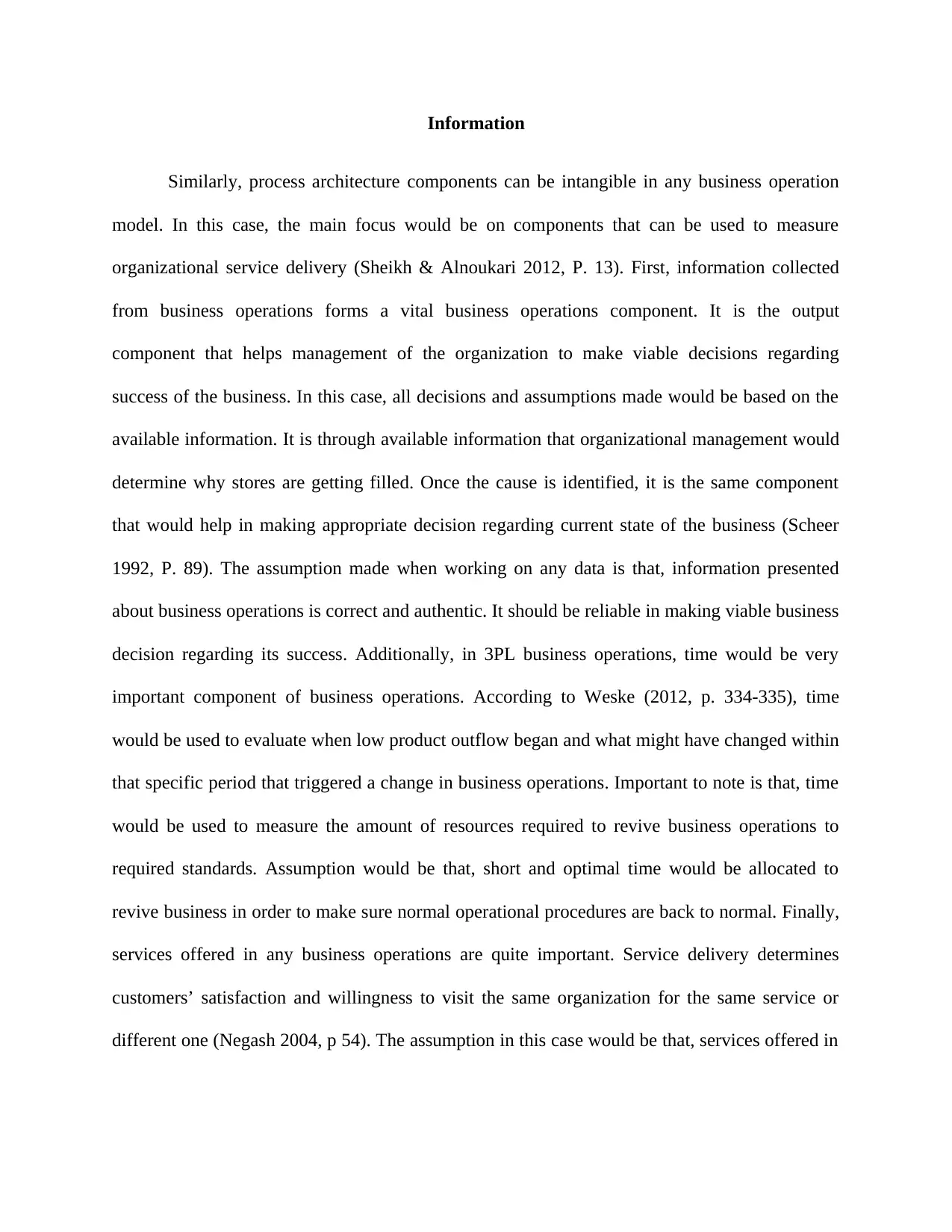
Information
Similarly, process architecture components can be intangible in any business operation
model. In this case, the main focus would be on components that can be used to measure
organizational service delivery (Sheikh & Alnoukari 2012, P. 13). First, information collected
from business operations forms a vital business operations component. It is the output
component that helps management of the organization to make viable decisions regarding
success of the business. In this case, all decisions and assumptions made would be based on the
available information. It is through available information that organizational management would
determine why stores are getting filled. Once the cause is identified, it is the same component
that would help in making appropriate decision regarding current state of the business (Scheer
1992, P. 89). The assumption made when working on any data is that, information presented
about business operations is correct and authentic. It should be reliable in making viable business
decision regarding its success. Additionally, in 3PL business operations, time would be very
important component of business operations. According to Weske (2012, p. 334-335), time
would be used to evaluate when low product outflow began and what might have changed within
that specific period that triggered a change in business operations. Important to note is that, time
would be used to measure the amount of resources required to revive business operations to
required standards. Assumption would be that, short and optimal time would be allocated to
revive business in order to make sure normal operational procedures are back to normal. Finally,
services offered in any business operations are quite important. Service delivery determines
customers’ satisfaction and willingness to visit the same organization for the same service or
different one (Negash 2004, p 54). The assumption in this case would be that, services offered in
Similarly, process architecture components can be intangible in any business operation
model. In this case, the main focus would be on components that can be used to measure
organizational service delivery (Sheikh & Alnoukari 2012, P. 13). First, information collected
from business operations forms a vital business operations component. It is the output
component that helps management of the organization to make viable decisions regarding
success of the business. In this case, all decisions and assumptions made would be based on the
available information. It is through available information that organizational management would
determine why stores are getting filled. Once the cause is identified, it is the same component
that would help in making appropriate decision regarding current state of the business (Scheer
1992, P. 89). The assumption made when working on any data is that, information presented
about business operations is correct and authentic. It should be reliable in making viable business
decision regarding its success. Additionally, in 3PL business operations, time would be very
important component of business operations. According to Weske (2012, p. 334-335), time
would be used to evaluate when low product outflow began and what might have changed within
that specific period that triggered a change in business operations. Important to note is that, time
would be used to measure the amount of resources required to revive business operations to
required standards. Assumption would be that, short and optimal time would be allocated to
revive business in order to make sure normal operational procedures are back to normal. Finally,
services offered in any business operations are quite important. Service delivery determines
customers’ satisfaction and willingness to visit the same organization for the same service or
different one (Negash 2004, p 54). The assumption in this case would be that, services offered in
⊘ This is a preview!⊘
Do you want full access?
Subscribe today to unlock all pages.

Trusted by 1+ million students worldwide
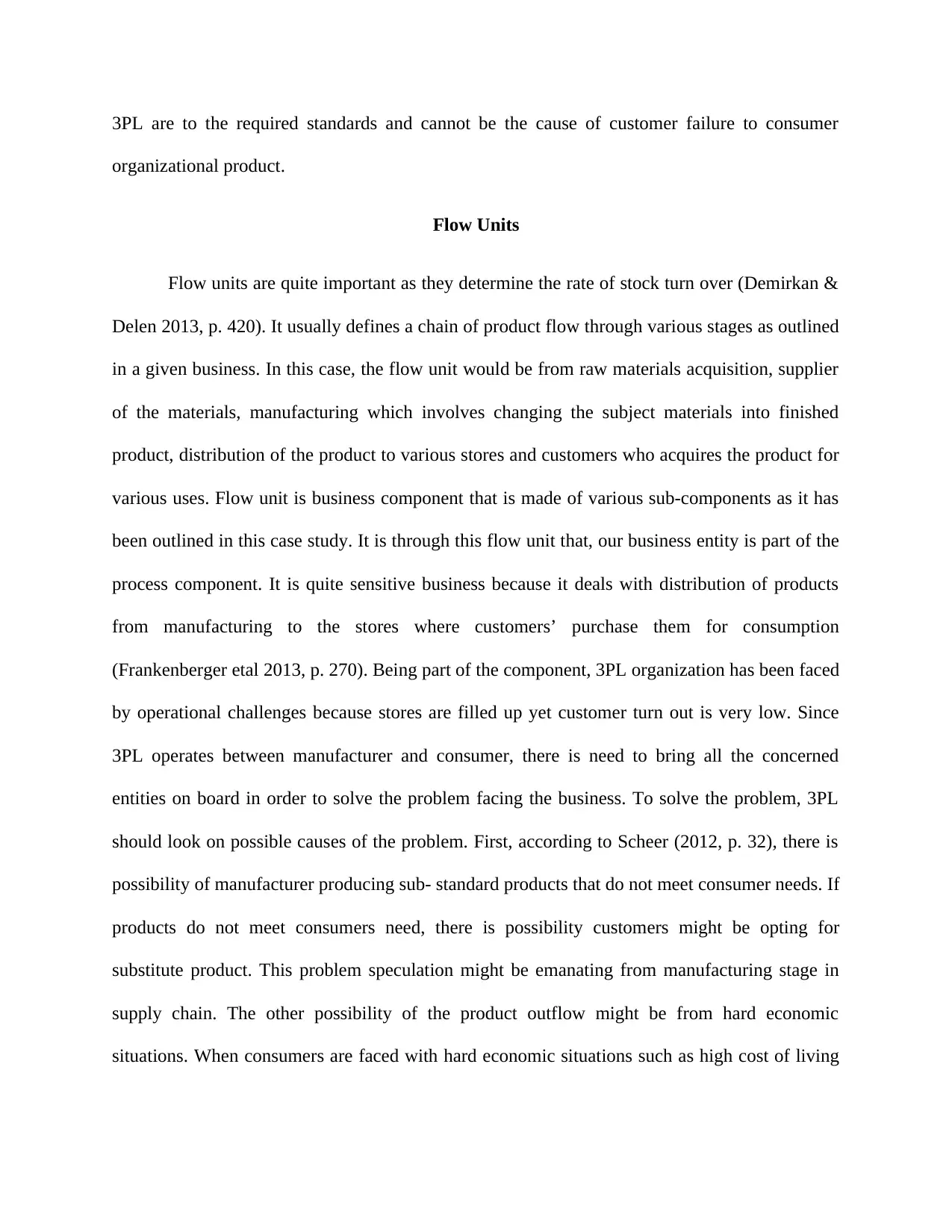
3PL are to the required standards and cannot be the cause of customer failure to consumer
organizational product.
Flow Units
Flow units are quite important as they determine the rate of stock turn over (Demirkan &
Delen 2013, p. 420). It usually defines a chain of product flow through various stages as outlined
in a given business. In this case, the flow unit would be from raw materials acquisition, supplier
of the materials, manufacturing which involves changing the subject materials into finished
product, distribution of the product to various stores and customers who acquires the product for
various uses. Flow unit is business component that is made of various sub-components as it has
been outlined in this case study. It is through this flow unit that, our business entity is part of the
process component. It is quite sensitive business because it deals with distribution of products
from manufacturing to the stores where customers’ purchase them for consumption
(Frankenberger etal 2013, p. 270). Being part of the component, 3PL organization has been faced
by operational challenges because stores are filled up yet customer turn out is very low. Since
3PL operates between manufacturer and consumer, there is need to bring all the concerned
entities on board in order to solve the problem facing the business. To solve the problem, 3PL
should look on possible causes of the problem. First, according to Scheer (2012, p. 32), there is
possibility of manufacturer producing sub- standard products that do not meet consumer needs. If
products do not meet consumers need, there is possibility customers might be opting for
substitute product. This problem speculation might be emanating from manufacturing stage in
supply chain. The other possibility of the product outflow might be from hard economic
situations. When consumers are faced with hard economic situations such as high cost of living
organizational product.
Flow Units
Flow units are quite important as they determine the rate of stock turn over (Demirkan &
Delen 2013, p. 420). It usually defines a chain of product flow through various stages as outlined
in a given business. In this case, the flow unit would be from raw materials acquisition, supplier
of the materials, manufacturing which involves changing the subject materials into finished
product, distribution of the product to various stores and customers who acquires the product for
various uses. Flow unit is business component that is made of various sub-components as it has
been outlined in this case study. It is through this flow unit that, our business entity is part of the
process component. It is quite sensitive business because it deals with distribution of products
from manufacturing to the stores where customers’ purchase them for consumption
(Frankenberger etal 2013, p. 270). Being part of the component, 3PL organization has been faced
by operational challenges because stores are filled up yet customer turn out is very low. Since
3PL operates between manufacturer and consumer, there is need to bring all the concerned
entities on board in order to solve the problem facing the business. To solve the problem, 3PL
should look on possible causes of the problem. First, according to Scheer (2012, p. 32), there is
possibility of manufacturer producing sub- standard products that do not meet consumer needs. If
products do not meet consumers need, there is possibility customers might be opting for
substitute product. This problem speculation might be emanating from manufacturing stage in
supply chain. The other possibility of the product outflow might be from hard economic
situations. When consumers are faced with hard economic situations such as high cost of living
Paraphrase This Document
Need a fresh take? Get an instant paraphrase of this document with our AI Paraphraser
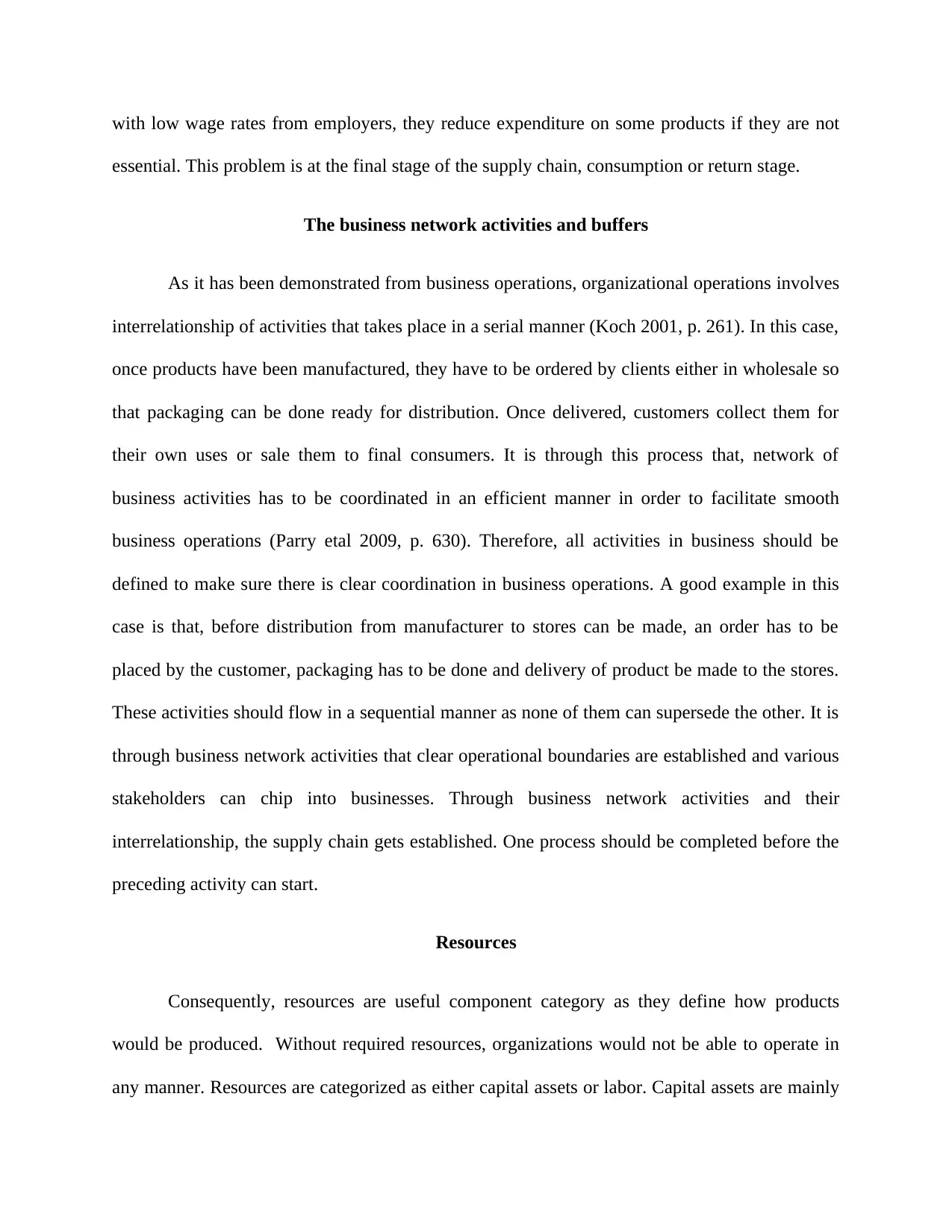
with low wage rates from employers, they reduce expenditure on some products if they are not
essential. This problem is at the final stage of the supply chain, consumption or return stage.
The business network activities and buffers
As it has been demonstrated from business operations, organizational operations involves
interrelationship of activities that takes place in a serial manner (Koch 2001, p. 261). In this case,
once products have been manufactured, they have to be ordered by clients either in wholesale so
that packaging can be done ready for distribution. Once delivered, customers collect them for
their own uses or sale them to final consumers. It is through this process that, network of
business activities has to be coordinated in an efficient manner in order to facilitate smooth
business operations (Parry etal 2009, p. 630). Therefore, all activities in business should be
defined to make sure there is clear coordination in business operations. A good example in this
case is that, before distribution from manufacturer to stores can be made, an order has to be
placed by the customer, packaging has to be done and delivery of product be made to the stores.
These activities should flow in a sequential manner as none of them can supersede the other. It is
through business network activities that clear operational boundaries are established and various
stakeholders can chip into businesses. Through business network activities and their
interrelationship, the supply chain gets established. One process should be completed before the
preceding activity can start.
Resources
Consequently, resources are useful component category as they define how products
would be produced. Without required resources, organizations would not be able to operate in
any manner. Resources are categorized as either capital assets or labor. Capital assets are mainly
essential. This problem is at the final stage of the supply chain, consumption or return stage.
The business network activities and buffers
As it has been demonstrated from business operations, organizational operations involves
interrelationship of activities that takes place in a serial manner (Koch 2001, p. 261). In this case,
once products have been manufactured, they have to be ordered by clients either in wholesale so
that packaging can be done ready for distribution. Once delivered, customers collect them for
their own uses or sale them to final consumers. It is through this process that, network of
business activities has to be coordinated in an efficient manner in order to facilitate smooth
business operations (Parry etal 2009, p. 630). Therefore, all activities in business should be
defined to make sure there is clear coordination in business operations. A good example in this
case is that, before distribution from manufacturer to stores can be made, an order has to be
placed by the customer, packaging has to be done and delivery of product be made to the stores.
These activities should flow in a sequential manner as none of them can supersede the other. It is
through business network activities that clear operational boundaries are established and various
stakeholders can chip into businesses. Through business network activities and their
interrelationship, the supply chain gets established. One process should be completed before the
preceding activity can start.
Resources
Consequently, resources are useful component category as they define how products
would be produced. Without required resources, organizations would not be able to operate in
any manner. Resources are categorized as either capital assets or labor. Capital assets are mainly
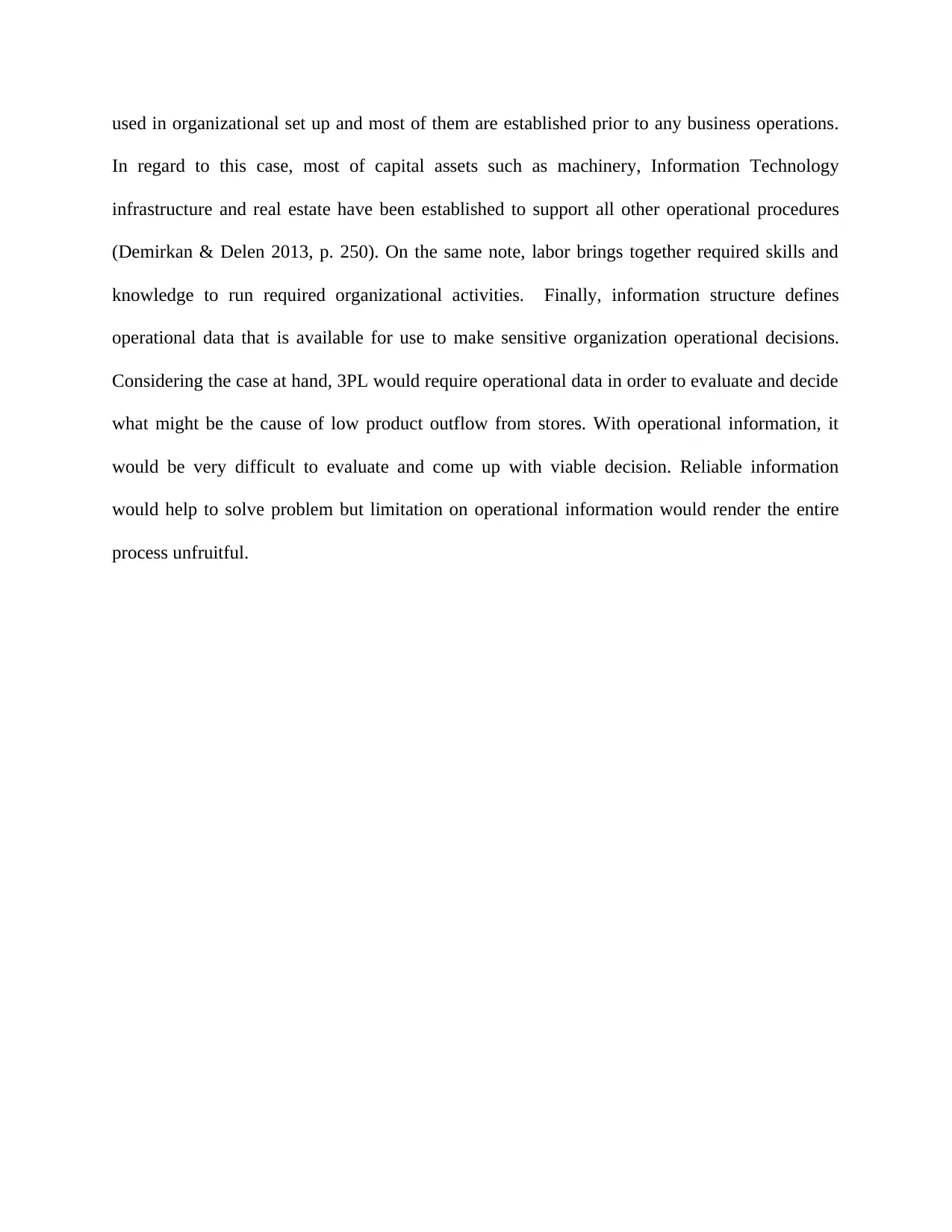
used in organizational set up and most of them are established prior to any business operations.
In regard to this case, most of capital assets such as machinery, Information Technology
infrastructure and real estate have been established to support all other operational procedures
(Demirkan & Delen 2013, p. 250). On the same note, labor brings together required skills and
knowledge to run required organizational activities. Finally, information structure defines
operational data that is available for use to make sensitive organization operational decisions.
Considering the case at hand, 3PL would require operational data in order to evaluate and decide
what might be the cause of low product outflow from stores. With operational information, it
would be very difficult to evaluate and come up with viable decision. Reliable information
would help to solve problem but limitation on operational information would render the entire
process unfruitful.
In regard to this case, most of capital assets such as machinery, Information Technology
infrastructure and real estate have been established to support all other operational procedures
(Demirkan & Delen 2013, p. 250). On the same note, labor brings together required skills and
knowledge to run required organizational activities. Finally, information structure defines
operational data that is available for use to make sensitive organization operational decisions.
Considering the case at hand, 3PL would require operational data in order to evaluate and decide
what might be the cause of low product outflow from stores. With operational information, it
would be very difficult to evaluate and come up with viable decision. Reliable information
would help to solve problem but limitation on operational information would render the entire
process unfruitful.
⊘ This is a preview!⊘
Do you want full access?
Subscribe today to unlock all pages.

Trusted by 1+ million students worldwide
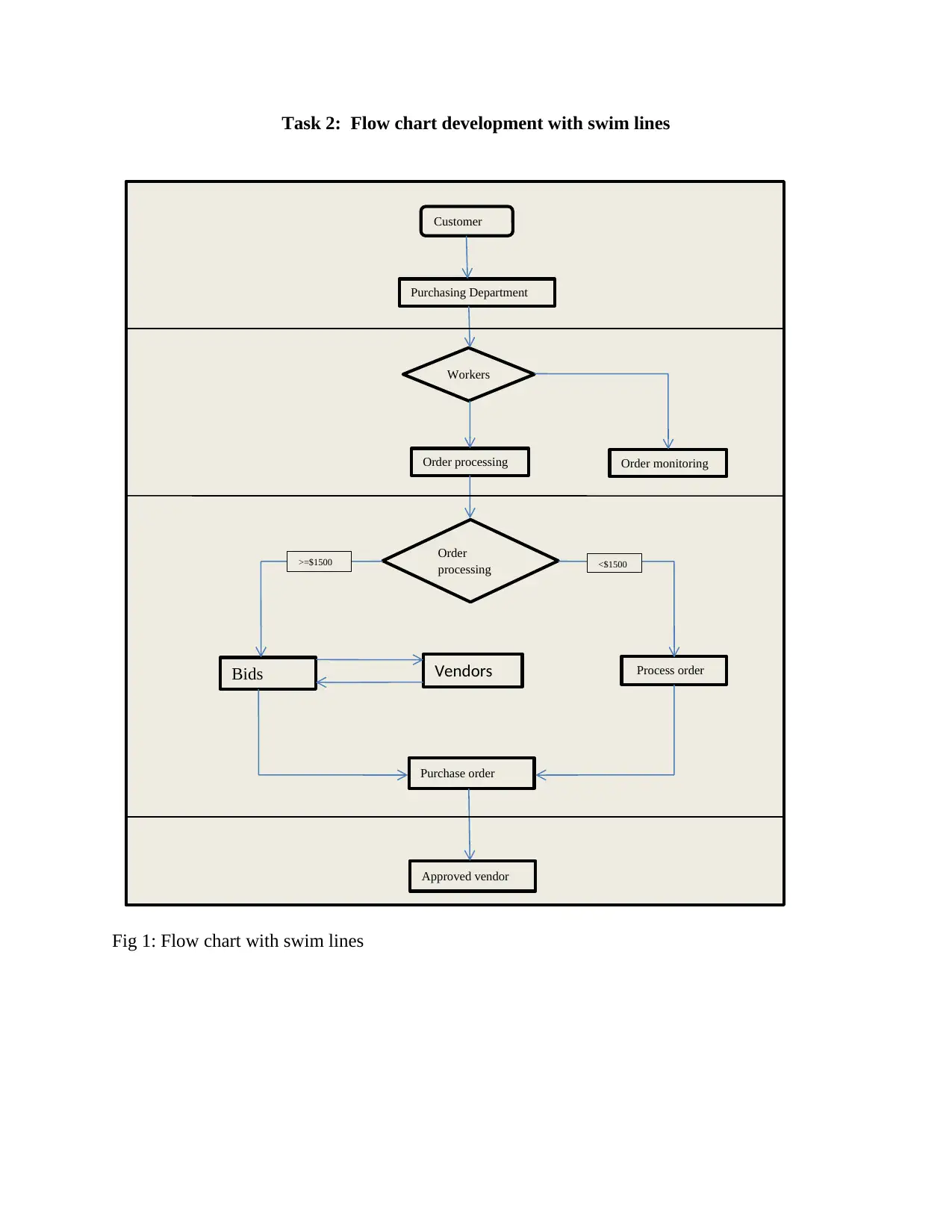
Task 2: Flow chart development with swim lines
Fig 1: Flow chart with swim lines
>=$1500 <$1500
Purchase order
Order processing
Bids
Approved vendor
Order
processing
Vendors Process order
Order monitoring
Workers
Purchasing Department
Customer
Fig 1: Flow chart with swim lines
>=$1500 <$1500
Purchase order
Order processing
Bids
Approved vendor
Order
processing
Vendors Process order
Order monitoring
Workers
Purchasing Department
Customer
Paraphrase This Document
Need a fresh take? Get an instant paraphrase of this document with our AI Paraphraser
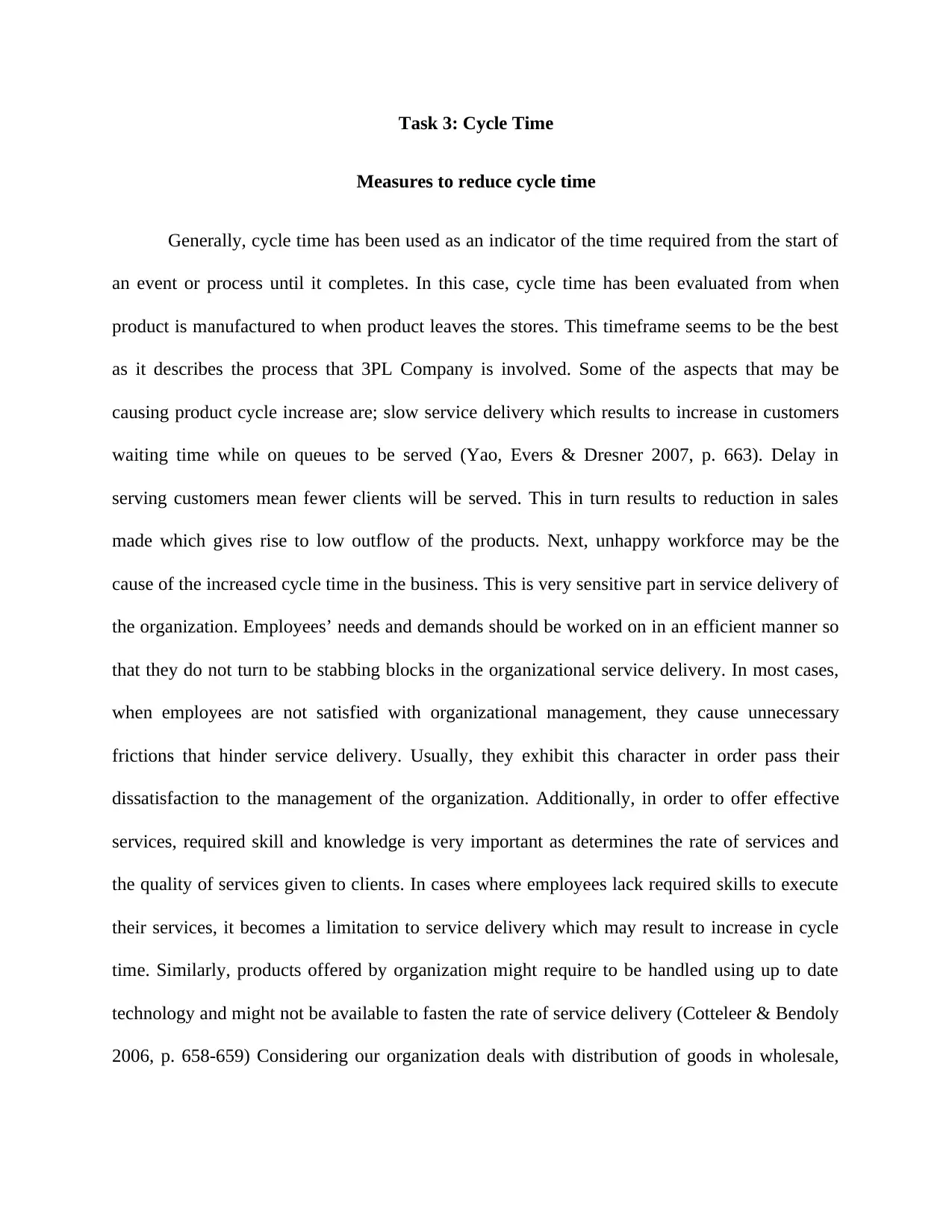
Task 3: Cycle Time
Measures to reduce cycle time
Generally, cycle time has been used as an indicator of the time required from the start of
an event or process until it completes. In this case, cycle time has been evaluated from when
product is manufactured to when product leaves the stores. This timeframe seems to be the best
as it describes the process that 3PL Company is involved. Some of the aspects that may be
causing product cycle increase are; slow service delivery which results to increase in customers
waiting time while on queues to be served (Yao, Evers & Dresner 2007, p. 663). Delay in
serving customers mean fewer clients will be served. This in turn results to reduction in sales
made which gives rise to low outflow of the products. Next, unhappy workforce may be the
cause of the increased cycle time in the business. This is very sensitive part in service delivery of
the organization. Employees’ needs and demands should be worked on in an efficient manner so
that they do not turn to be stabbing blocks in the organizational service delivery. In most cases,
when employees are not satisfied with organizational management, they cause unnecessary
frictions that hinder service delivery. Usually, they exhibit this character in order pass their
dissatisfaction to the management of the organization. Additionally, in order to offer effective
services, required skill and knowledge is very important as determines the rate of services and
the quality of services given to clients. In cases where employees lack required skills to execute
their services, it becomes a limitation to service delivery which may result to increase in cycle
time. Similarly, products offered by organization might require to be handled using up to date
technology and might not be available to fasten the rate of service delivery (Cotteleer & Bendoly
2006, p. 658-659) Considering our organization deals with distribution of goods in wholesale,
Measures to reduce cycle time
Generally, cycle time has been used as an indicator of the time required from the start of
an event or process until it completes. In this case, cycle time has been evaluated from when
product is manufactured to when product leaves the stores. This timeframe seems to be the best
as it describes the process that 3PL Company is involved. Some of the aspects that may be
causing product cycle increase are; slow service delivery which results to increase in customers
waiting time while on queues to be served (Yao, Evers & Dresner 2007, p. 663). Delay in
serving customers mean fewer clients will be served. This in turn results to reduction in sales
made which gives rise to low outflow of the products. Next, unhappy workforce may be the
cause of the increased cycle time in the business. This is very sensitive part in service delivery of
the organization. Employees’ needs and demands should be worked on in an efficient manner so
that they do not turn to be stabbing blocks in the organizational service delivery. In most cases,
when employees are not satisfied with organizational management, they cause unnecessary
frictions that hinder service delivery. Usually, they exhibit this character in order pass their
dissatisfaction to the management of the organization. Additionally, in order to offer effective
services, required skill and knowledge is very important as determines the rate of services and
the quality of services given to clients. In cases where employees lack required skills to execute
their services, it becomes a limitation to service delivery which may result to increase in cycle
time. Similarly, products offered by organization might require to be handled using up to date
technology and might not be available to fasten the rate of service delivery (Cotteleer & Bendoly
2006, p. 658-659) Considering our organization deals with distribution of goods in wholesale,
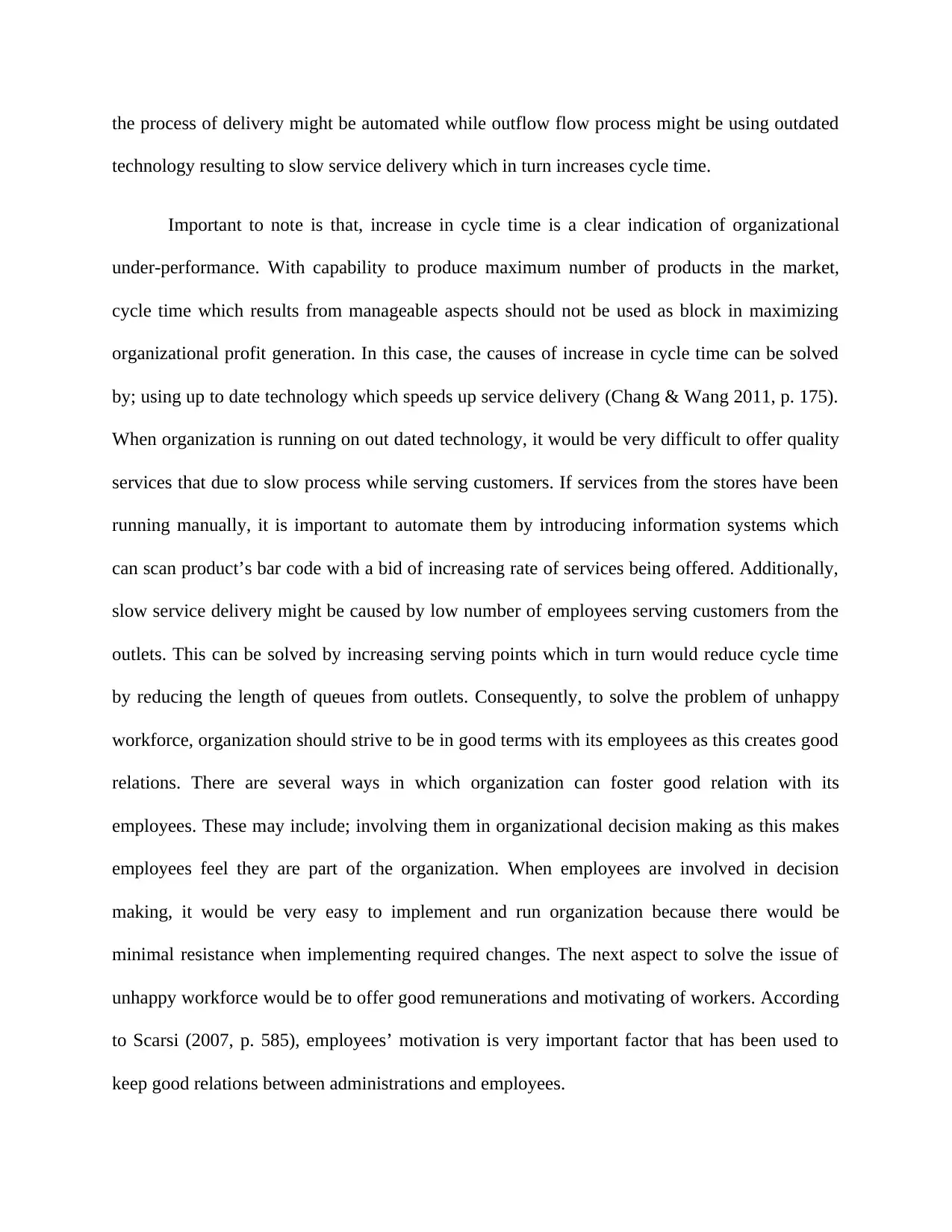
the process of delivery might be automated while outflow flow process might be using outdated
technology resulting to slow service delivery which in turn increases cycle time.
Important to note is that, increase in cycle time is a clear indication of organizational
under-performance. With capability to produce maximum number of products in the market,
cycle time which results from manageable aspects should not be used as block in maximizing
organizational profit generation. In this case, the causes of increase in cycle time can be solved
by; using up to date technology which speeds up service delivery (Chang & Wang 2011, p. 175).
When organization is running on out dated technology, it would be very difficult to offer quality
services that due to slow process while serving customers. If services from the stores have been
running manually, it is important to automate them by introducing information systems which
can scan product’s bar code with a bid of increasing rate of services being offered. Additionally,
slow service delivery might be caused by low number of employees serving customers from the
outlets. This can be solved by increasing serving points which in turn would reduce cycle time
by reducing the length of queues from outlets. Consequently, to solve the problem of unhappy
workforce, organization should strive to be in good terms with its employees as this creates good
relations. There are several ways in which organization can foster good relation with its
employees. These may include; involving them in organizational decision making as this makes
employees feel they are part of the organization. When employees are involved in decision
making, it would be very easy to implement and run organization because there would be
minimal resistance when implementing required changes. The next aspect to solve the issue of
unhappy workforce would be to offer good remunerations and motivating of workers. According
to Scarsi (2007, p. 585), employees’ motivation is very important factor that has been used to
keep good relations between administrations and employees.
technology resulting to slow service delivery which in turn increases cycle time.
Important to note is that, increase in cycle time is a clear indication of organizational
under-performance. With capability to produce maximum number of products in the market,
cycle time which results from manageable aspects should not be used as block in maximizing
organizational profit generation. In this case, the causes of increase in cycle time can be solved
by; using up to date technology which speeds up service delivery (Chang & Wang 2011, p. 175).
When organization is running on out dated technology, it would be very difficult to offer quality
services that due to slow process while serving customers. If services from the stores have been
running manually, it is important to automate them by introducing information systems which
can scan product’s bar code with a bid of increasing rate of services being offered. Additionally,
slow service delivery might be caused by low number of employees serving customers from the
outlets. This can be solved by increasing serving points which in turn would reduce cycle time
by reducing the length of queues from outlets. Consequently, to solve the problem of unhappy
workforce, organization should strive to be in good terms with its employees as this creates good
relations. There are several ways in which organization can foster good relation with its
employees. These may include; involving them in organizational decision making as this makes
employees feel they are part of the organization. When employees are involved in decision
making, it would be very easy to implement and run organization because there would be
minimal resistance when implementing required changes. The next aspect to solve the issue of
unhappy workforce would be to offer good remunerations and motivating of workers. According
to Scarsi (2007, p. 585), employees’ motivation is very important factor that has been used to
keep good relations between administrations and employees.
⊘ This is a preview!⊘
Do you want full access?
Subscribe today to unlock all pages.

Trusted by 1+ million students worldwide
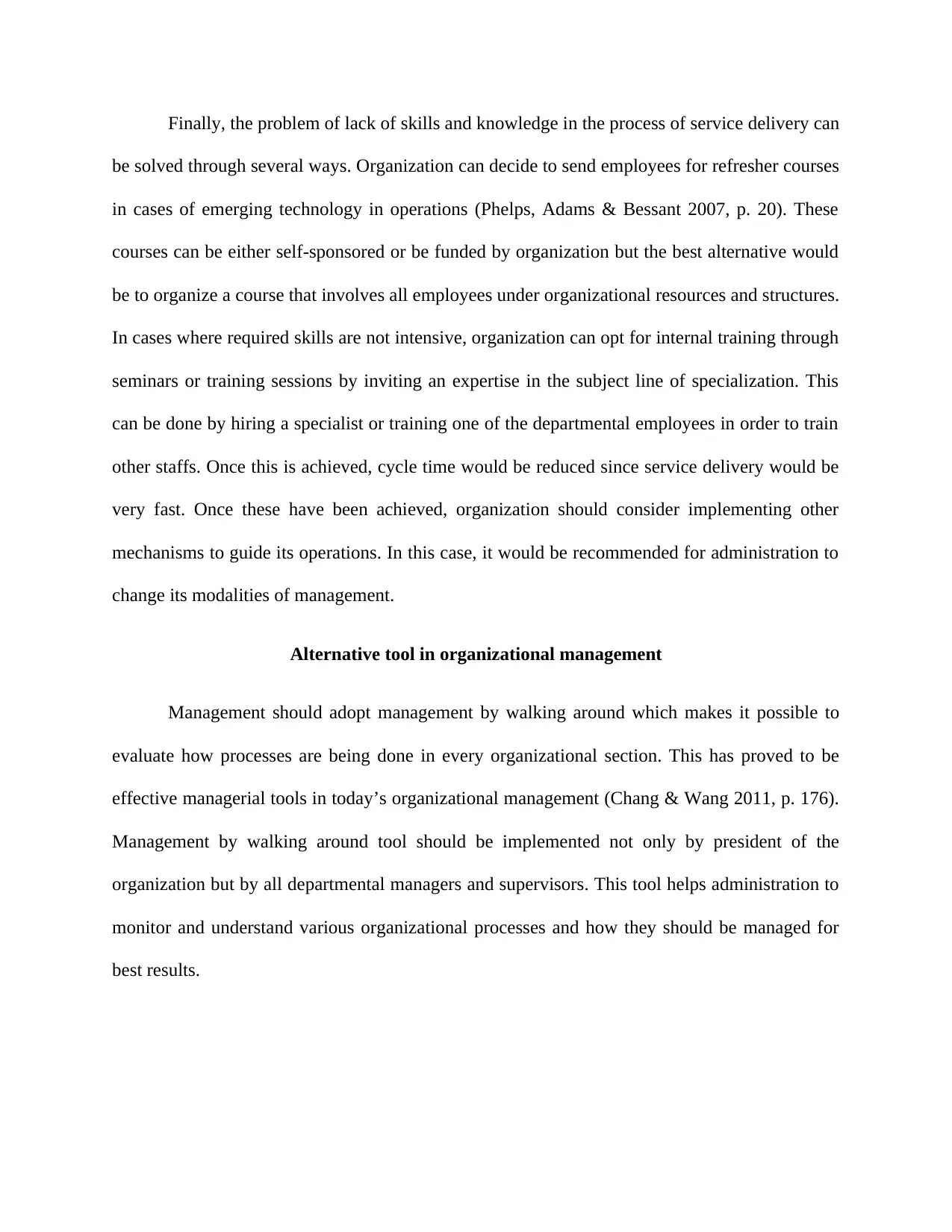
Finally, the problem of lack of skills and knowledge in the process of service delivery can
be solved through several ways. Organization can decide to send employees for refresher courses
in cases of emerging technology in operations (Phelps, Adams & Bessant 2007, p. 20). These
courses can be either self-sponsored or be funded by organization but the best alternative would
be to organize a course that involves all employees under organizational resources and structures.
In cases where required skills are not intensive, organization can opt for internal training through
seminars or training sessions by inviting an expertise in the subject line of specialization. This
can be done by hiring a specialist or training one of the departmental employees in order to train
other staffs. Once this is achieved, cycle time would be reduced since service delivery would be
very fast. Once these have been achieved, organization should consider implementing other
mechanisms to guide its operations. In this case, it would be recommended for administration to
change its modalities of management.
Alternative tool in organizational management
Management should adopt management by walking around which makes it possible to
evaluate how processes are being done in every organizational section. This has proved to be
effective managerial tools in today’s organizational management (Chang & Wang 2011, p. 176).
Management by walking around tool should be implemented not only by president of the
organization but by all departmental managers and supervisors. This tool helps administration to
monitor and understand various organizational processes and how they should be managed for
best results.
be solved through several ways. Organization can decide to send employees for refresher courses
in cases of emerging technology in operations (Phelps, Adams & Bessant 2007, p. 20). These
courses can be either self-sponsored or be funded by organization but the best alternative would
be to organize a course that involves all employees under organizational resources and structures.
In cases where required skills are not intensive, organization can opt for internal training through
seminars or training sessions by inviting an expertise in the subject line of specialization. This
can be done by hiring a specialist or training one of the departmental employees in order to train
other staffs. Once this is achieved, cycle time would be reduced since service delivery would be
very fast. Once these have been achieved, organization should consider implementing other
mechanisms to guide its operations. In this case, it would be recommended for administration to
change its modalities of management.
Alternative tool in organizational management
Management should adopt management by walking around which makes it possible to
evaluate how processes are being done in every organizational section. This has proved to be
effective managerial tools in today’s organizational management (Chang & Wang 2011, p. 176).
Management by walking around tool should be implemented not only by president of the
organization but by all departmental managers and supervisors. This tool helps administration to
monitor and understand various organizational processes and how they should be managed for
best results.
Paraphrase This Document
Need a fresh take? Get an instant paraphrase of this document with our AI Paraphraser
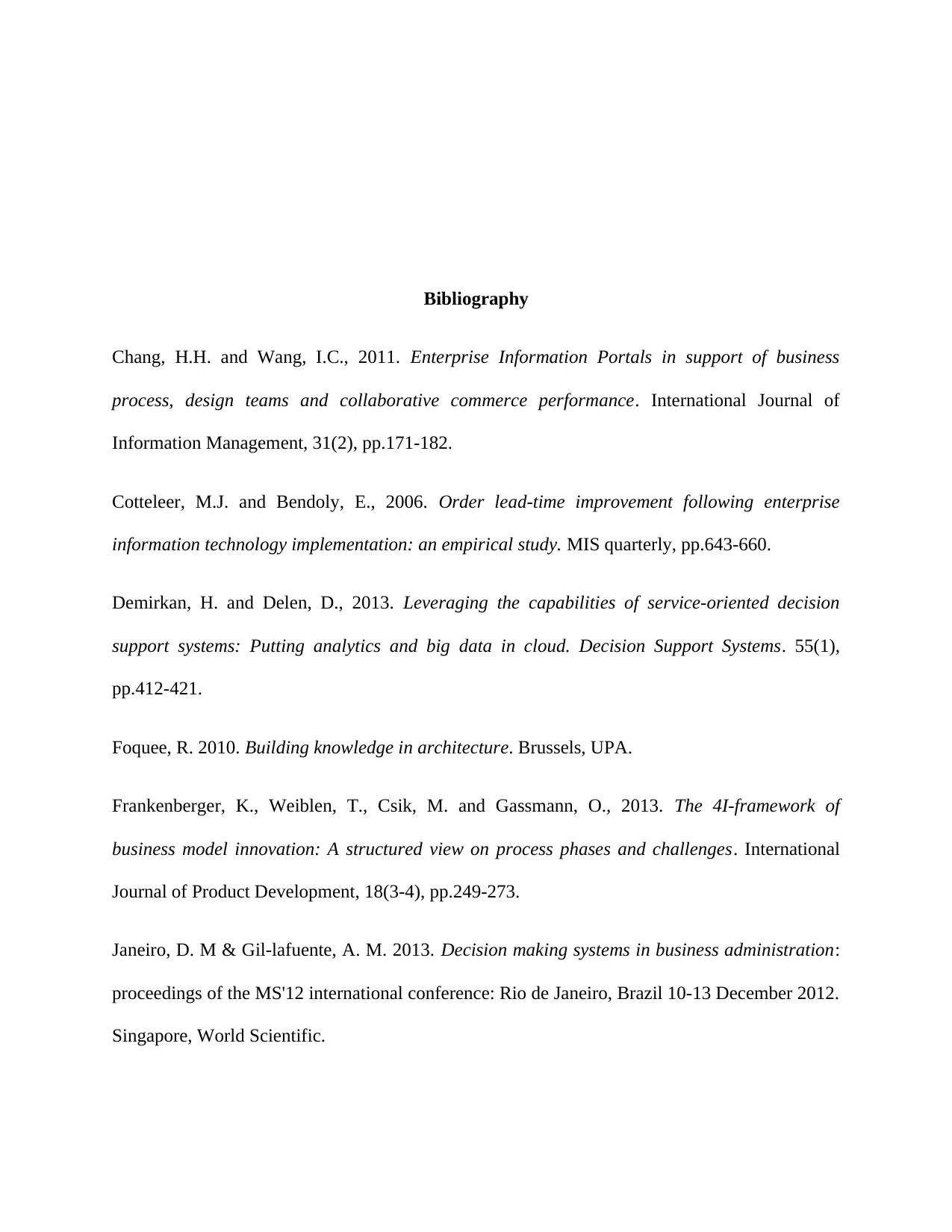
Bibliography
Chang, H.H. and Wang, I.C., 2011. Enterprise Information Portals in support of business
process, design teams and collaborative commerce performance. International Journal of
Information Management, 31(2), pp.171-182.
Cotteleer, M.J. and Bendoly, E., 2006. Order lead-time improvement following enterprise
information technology implementation: an empirical study. MIS quarterly, pp.643-660.
Demirkan, H. and Delen, D., 2013. Leveraging the capabilities of service-oriented decision
support systems: Putting analytics and big data in cloud. Decision Support Systems. 55(1),
pp.412-421.
Foquee, R. 2010. Building knowledge in architecture. Brussels, UPA.
Frankenberger, K., Weiblen, T., Csik, M. and Gassmann, O., 2013. The 4I-framework of
business model innovation: A structured view on process phases and challenges. International
Journal of Product Development, 18(3-4), pp.249-273.
Janeiro, D. M & Gil-lafuente, A. M. 2013. Decision making systems in business administration:
proceedings of the MS'12 international conference: Rio de Janeiro, Brazil 10-13 December 2012.
Singapore, World Scientific.
Chang, H.H. and Wang, I.C., 2011. Enterprise Information Portals in support of business
process, design teams and collaborative commerce performance. International Journal of
Information Management, 31(2), pp.171-182.
Cotteleer, M.J. and Bendoly, E., 2006. Order lead-time improvement following enterprise
information technology implementation: an empirical study. MIS quarterly, pp.643-660.
Demirkan, H. and Delen, D., 2013. Leveraging the capabilities of service-oriented decision
support systems: Putting analytics and big data in cloud. Decision Support Systems. 55(1),
pp.412-421.
Foquee, R. 2010. Building knowledge in architecture. Brussels, UPA.
Frankenberger, K., Weiblen, T., Csik, M. and Gassmann, O., 2013. The 4I-framework of
business model innovation: A structured view on process phases and challenges. International
Journal of Product Development, 18(3-4), pp.249-273.
Janeiro, D. M & Gil-lafuente, A. M. 2013. Decision making systems in business administration:
proceedings of the MS'12 international conference: Rio de Janeiro, Brazil 10-13 December 2012.
Singapore, World Scientific.
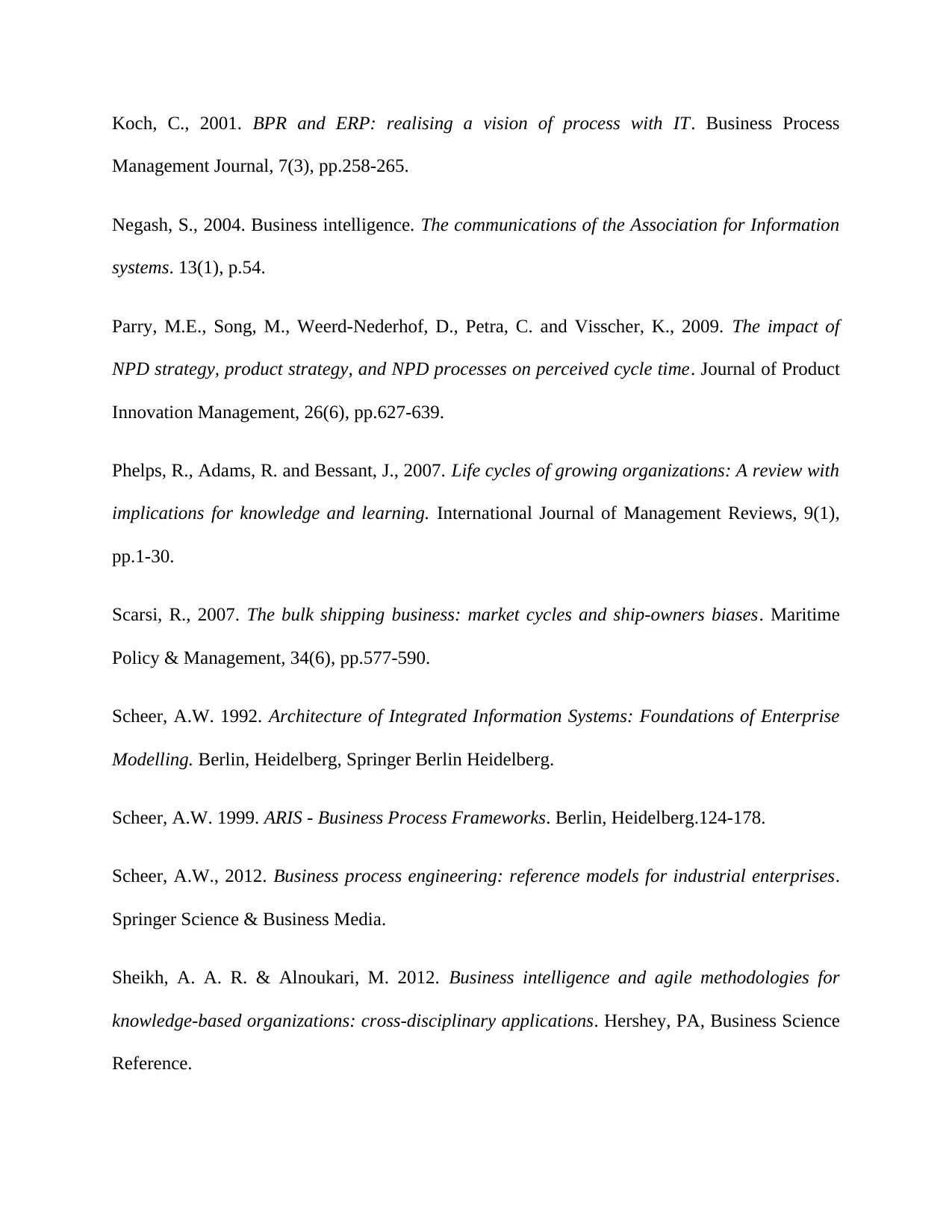
Koch, C., 2001. BPR and ERP: realising a vision of process with IT. Business Process
Management Journal, 7(3), pp.258-265.
Negash, S., 2004. Business intelligence. The communications of the Association for Information
systems. 13(1), p.54.
Parry, M.E., Song, M., Weerd‐Nederhof, D., Petra, C. and Visscher, K., 2009. The impact of
NPD strategy, product strategy, and NPD processes on perceived cycle time. Journal of Product
Innovation Management, 26(6), pp.627-639.
Phelps, R., Adams, R. and Bessant, J., 2007. Life cycles of growing organizations: A review with
implications for knowledge and learning. International Journal of Management Reviews, 9(1),
pp.1-30.
Scarsi, R., 2007. The bulk shipping business: market cycles and ship-owners biases. Maritime
Policy & Management, 34(6), pp.577-590.
Scheer, A.W. 1992. Architecture of Integrated Information Systems: Foundations of Enterprise
Modelling. Berlin, Heidelberg, Springer Berlin Heidelberg.
Scheer, A.W. 1999. ARIS - Business Process Frameworks. Berlin, Heidelberg.124-178.
Scheer, A.W., 2012. Business process engineering: reference models for industrial enterprises.
Springer Science & Business Media.
Sheikh, A. A. R. & Alnoukari, M. 2012. Business intelligence and agile methodologies for
knowledge-based organizations: cross-disciplinary applications. Hershey, PA, Business Science
Reference.
Management Journal, 7(3), pp.258-265.
Negash, S., 2004. Business intelligence. The communications of the Association for Information
systems. 13(1), p.54.
Parry, M.E., Song, M., Weerd‐Nederhof, D., Petra, C. and Visscher, K., 2009. The impact of
NPD strategy, product strategy, and NPD processes on perceived cycle time. Journal of Product
Innovation Management, 26(6), pp.627-639.
Phelps, R., Adams, R. and Bessant, J., 2007. Life cycles of growing organizations: A review with
implications for knowledge and learning. International Journal of Management Reviews, 9(1),
pp.1-30.
Scarsi, R., 2007. The bulk shipping business: market cycles and ship-owners biases. Maritime
Policy & Management, 34(6), pp.577-590.
Scheer, A.W. 1992. Architecture of Integrated Information Systems: Foundations of Enterprise
Modelling. Berlin, Heidelberg, Springer Berlin Heidelberg.
Scheer, A.W. 1999. ARIS - Business Process Frameworks. Berlin, Heidelberg.124-178.
Scheer, A.W., 2012. Business process engineering: reference models for industrial enterprises.
Springer Science & Business Media.
Sheikh, A. A. R. & Alnoukari, M. 2012. Business intelligence and agile methodologies for
knowledge-based organizations: cross-disciplinary applications. Hershey, PA, Business Science
Reference.
⊘ This is a preview!⊘
Do you want full access?
Subscribe today to unlock all pages.

Trusted by 1+ million students worldwide
1 out of 13
Related Documents
Your All-in-One AI-Powered Toolkit for Academic Success.
+13062052269
info@desklib.com
Available 24*7 on WhatsApp / Email
![[object Object]](/_next/static/media/star-bottom.7253800d.svg)
Unlock your academic potential
Copyright © 2020–2025 A2Z Services. All Rights Reserved. Developed and managed by ZUCOL.





